
Omicron Is “Extremely Mild” Says Doctor Who First Discovered Strain; Numerous Mutations “Destabilize” The Virus
“The cases that have occurred so far have all been mild cases, mild-to-moderate cases, and that’s a good sign,” said Schoub, adding that it was still early days and nothing was certain yet.
By Tyler Durden | Zero Hedge
With Fauci, big government fanatics, Democrat officials, and the biopharma lobby all turning the Omicron (not to be confused with Xi as the WHO explained earlier) variant fear mongering to max, a few holdouts are still trying to maintain a lack of panic (even if that means less revenue for makers of Pfizer and Moderna megayachts).
One, as we noted last night, is Goldman which said that the bank has a “reasonable degree of confidence that this mutation is unlikely to be more malicious and that the existing vaccines will most likely continue to be effective.”
Then this morning, the Pretoria doctor who first sounded the alarm about the new strain and who is a Covid-19 adviser to the South Africa government said that symptoms linked to the omicron coronavirus variant have been mild so far.
Contrary to the panicmongering unleashed by western mainstream median, Barry Schoub, chairman of the Ministerial Advisory Committee on Vaccines, told Sky News on Sunday that while South Africa, which first identified the new variant, currently has 3,220 people with the coronavirus infection overall and while the variant does appear to be spreading rapidly, there’s been no real uptick in hospitalizations
“The cases that have occurred so far have all been mild cases, mild-to-moderate cases, and that’s a good sign,” said Schoub, adding that it was still early days and nothing was certain yet.
Most importantly, and running counter to the fear mongering narrative being pumped out 24/7 by the mainstream media, Schoub said that the large number of mutations found in the omicron variant appears to destabilize the virus, which might make it less “fit” than the dominant delta strain.
While South Africa, where the Omicron strain first emerged in early November, has been hit with a number of travel bans from the U.K. and other nations, after its scientists found the mutated variant last week, since then a growing number of European countries, along with Australia, have also identified people infected with the variant.
“In a way, hopefully it won’t displace delta because delta we know responds very well to the vaccine,” he said.
At the same time, one could make the point that while Omicron could soon become the dominant strain due to its higher R-nought (or pace of transmission), that could be a blessing in disguise as it pushes out the much more dangerous (and more stable) delta strain.
It wasn’t just Schoub seeking to taper the fear mongering: Angelique Coetzee, chair of the South African Medical Association, agreed with Schoub’s assessment calling symptoms associated with the variant at this point “different and so mild” compared with others she’d treated for the virus in recent months.
Coetzee, who first spotted what turned out to be the new variant, told the U.K. Telegraph that a number of healthy young men turned up at her clinic “feeling so tired.” About half were unvaccinated.
Speaking to the Telegraph, she said that “Their symptoms were so different and so mild from those I had treated before,” Coetzee told The Telegraph.
Most of the patients who turned up to her clinic and have tested positive for COVID-19 felt tired. Other symptoms included sore muscles and a slight cough, Coetzee added to Sputnik.
“There are no prominent symptoms. Of those infected, some are currently being treated at home,” she said.
“What we are seeing clinically in South Africa and remember, I’m at the epicentre, that’s where I’m practicing, is extremely mild,” she said Sunday on the BBC’s “Andrew Marr Show.
"Round about the 18 November, I all of a sudden encountered unusual symptoms" in a patient who was "extremely tired for the past two days"
Dr Angelique Coetzee explains how she became aware of the Omicron coronavirus variant
https://t.co/RsskjmFkLd #Marr pic.twitter.com/pXtyYsQxxR— BBC Politics (@BBCPolitics) November 28, 2021
Speaking to the BBC, Coetzee said that doctors in the UK where panic over Omicron has exploded, “might be more focused on the Delta symptoms” and missing the much milder Omicron variant.
"I think you already have it there in your country," says the South African doctor who first raised concern over the Omicron variant
Dr Angelique Coetzee says UK doctors "might be more focused on the Delta symptoms" and missing the Omicron varianthttps://t.co/yTOMDgupgq #Marr pic.twitter.com/VmpPGCpxqm
— BBC Politics (@BBCPolitics) November 28, 2021
Even more remarkably, she said that “we haven’t admitted anyone” to the hospital with the new variant,” she said. “I spoke to other colleagues of mine, the same picture.”
Asked if authorities around the world were panicking unnecessarily, Coetzee said “yes, at this stage I would say definitely. Two weeks from now on maybe we will say something different.”
https://twitter.com/sailorrooscout/status/1464623035579879437?ref_src=twsrc%5Etfw%7Ctwcamp%5Etweetembed%7Ctwterm%5E1464624263797878791%7Ctwgr%5E%7Ctwcon%5Es2_&ref_url=https%3A%2F%2Fwww.zerohedge.com%2Fcovid-19%2Fomicron-extremely-mild-says-doctor-who-first-discovered-strain-numerous-mutations
Of course, none of these actual facts matter to those dealing in propaganda, such as Anthony Fauci, who instead of hoping to ease public concerns, said that the omicron variant appears to be more transmissible, and reinforcing the need for Americans to get vaccinations or booster shots.
Omicron “is a clarion call” for people to be vaccinated, said Biden’s top medical advisor on NBC’s “Meet the Press.” Infections in the U.S. are already rising and stepped-up prevention with the emergence of the new variant will impact whether Americans are “headed into a bleak or bleaker winter,” he said, in a vivid example of what Coetzee dubbed “unnecessary panicking.”
This article (Omicron Is “Extremely Mild” Says Doctor Who First Discovered Strain; Numerous Mutations “Destabilize” The Virus) was originally published on Zero Hedge and is published under a Creative Commons license.
